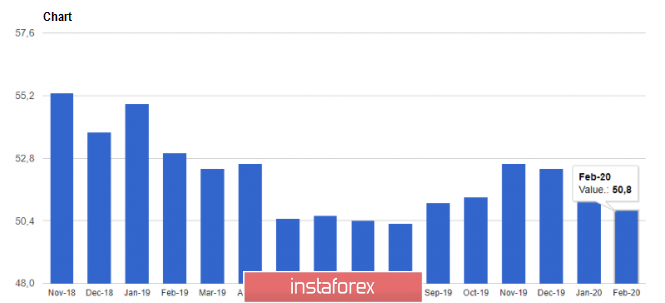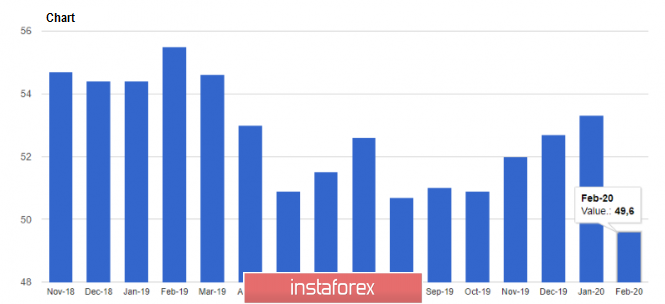Due to weak fundamental statistics released last Friday, the US dollar lost a number of positions against other major world currencies. The markets have been asking for a correction for a long time, however, as we can see on the chart, the growth of risk assets is again limited by news about the spread of the coronavirus, where an outbreak of which is now recorded in Italy. Gold has jumped in price, while the demand for euro and pound has slowed, which may possibly lead to a return to the lows of the year, as well as their breakdown.

The speeches made by Fed representatives also had a negative impact on the US dollar. This is because according to the managers, an increase in US interest rates this year is unlikely.
Moreover, sales in the secondary housing market in the United States declined in January, due to relatively high prices and small supply. According to the National Association of Realtors, as compared to December 2019, sales in the secondary housing market in January 2020 fell by 1.3% and amounted to 5.46 million homes per year. Meanwhile, economists had forecast a 2% decline in sales. Nevertheless, given the current interest rates and favorable economic conditions in the United States, we can expect a further increase in prices and sales growth in spring. As for the average price of homes in the secondary market, sales rose by 6.8% in January, and amounted to $ 266,300.
The dollar also reacted negatively to the news that business activity in the US manufacturing sector and services sector declined very seriously. This is a signal that the economy will likely slow down at the beginning of this year.
According to IHS Markit, the preliminary composite US purchasing managers' index (PMI) fell from 53.3 points to 49.6 points in February 2020. Note that a value below 50 indicates a decrease in activity. Markit noted that such a serious decline in business activity was last observed during the global financial crisis. Moreover, growth in the manufacturing sector declined due to a reduction in new orders.

For example, economists had expected the preliminary IHS Markit index for the manufacturing sector to be 51.5 points. However, it fell to 50.8 points instead. As for the PMI for the services sector, economists had forecasted it to be 53.2 points, but it fell to 49.4 points instead, against its 53.4 points in January.

The speech of the Fed governor, Lael Brainard, was about the US monetary policy. According to her, the Fed will need to maintain a soft monetary policy for a long time in order to reach the 2% inflation target. It needs to adopt a strategy that will keep inflation at this level in the long term. Meanwhile, during a downturn, Lael said that the Fed should promise to refrain from raising rates from near zero levels to counteract risks and stimulate economic growth, because she believes that a strong fiscal measures is important during a period of low interest rates.
In line with this, the President of the Federal Reserve Bank of Atlanta, Rafael Bostic, said in his speech that the Fed will not change interest rates in 2020. He claims that the risks to the economy are currently balanced, and he expects the US GDP to grow by 2%-2.25% in 2020. He expects further growth in the labor market as well.
As for the technical picture of the EUR/USD pair, Friday's sharp growth is gradually fading. The pressure from the spread of the coronavirus, as well as its impact on the world economy is increasing, negatively affecting the future prospects of risky assets, especially the European currency. If the sellers reach the lows of this year, the repeated test of the support at 1.0780 will most likely lead to a new wave of decline in the pair, updating the lows of 1.0740 and 1.0680. Meanwhile, the market participants' reaction to today's data on the German business activity index from the IFO Institute will indicate the direction of the euro. If good data does not trigger a rise in the currency from the support of 1.0820, then the market will most likely go further in a bearish scenario. At the same time, the upward correction will continue to be limited to the resistance levels of 1.0860 and 1.0920.
CAD
The loonie, like the retail sales in Canada in December 2019, remained unchanged in the narrow side channel. However, the risk of coronavirus may again negatively affect commodities, especially oil, which will put pressure on the currency, resuming its downward trend against the US dollar.
According to Statistics Canada, retail sales in December amounted to 51.68 billion Canadian dollars. Meanwhile, economists had expected the sales to increase by 0.1%. Let me remind you that in November 2019, sales jumped by 1.1% at once. The Bureau noted that if you take sales excluding cars and gasoline, the growth was 1.0% in December. Moreover, if compared to the same period of the previous year, sales increased by 2.4%.
 English
English 
 Русский
Русский Bahasa Indonesia
Bahasa Indonesia Bahasa Malay
Bahasa Malay ไทย
ไทย Español
Español Deutsch
Deutsch Български
Български Français
Français Tiếng Việt
Tiếng Việt 中文
中文 বাংলা
বাংলা हिन्दी
हिन्दी Čeština
Čeština Українська
Українська Română
Română

